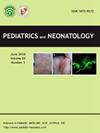Metabolomic profiles of preterm small-for-gestational age infants
IF 2.3
4区 医学
Q2 PEDIATRICS
引用次数: 0
Abstract
We aimed to characterize the metabolomic profiles in preterm small-for-gestational age (SGA) infants using cord blood. We conducted a gestational age (GA)-matched case-control study that included 30 preterm infants who were categorized into two groups: SGA infants, with a birth weight (BW) < 10th percentile for GA (n = 15) and non-SGA infants, with BW ≥ 10th percentile for GA (n = 15). SGA infants with chromosomal or genetic abnormalities were excluded. At birth, the umbilicus was double-clamped, and the cord blood was sampled from the umbilical vein. Metabolomic analyses were performed using capillary electrophoresis time-of-flight mass spectrometry. The median GA at birth was not significantly different between the two groups [SGA, 32 (26–36) weeks; non-SGA, 32 (25–35) weeks; p = 0.661)]. Of the 255 metabolites analyzed, 19 (7.5%) showed significant differences between SGA and non-SGA infants. There were significant reductions in the carnosine, hypotaurine, and S-methylcysteine levels in SGA infants as compared to non-SGA infants (p < 0.05). Carnosine was correlated with gestational age, BMI before pregnancy, body weight gain during pregnancy (p = 0.002, p = 0.023, and p = 0.020, respectively). In conclusion, preterm SGA infants have low levels of cord blood antioxidative- and antiglycation-related metabolites, making them vulnerable to oxidative stress.
小于胎龄早产儿的代谢组谱。
我们的目的是利用脐带血描述小胎龄早产儿(SGA)的代谢组特征。我们进行了一项与胎龄(GA)匹配的病例对照研究,将 30 名早产儿分为两组:SGA 婴儿,出生体重 (BW)
本文章由计算机程序翻译,如有差异,请以英文原文为准。
求助全文
约1分钟内获得全文
求助全文
来源期刊

Pediatrics and Neonatology
PEDIATRICS-
CiteScore
3.10
自引率
0.00%
发文量
170
审稿时长
48 days
期刊介绍:
Pediatrics and Neonatology is the official peer-reviewed publication of the Taiwan Pediatric Association and The Society of Neonatology ROC, and is indexed in EMBASE and SCOPUS. Articles on clinical and laboratory research in pediatrics and related fields are eligible for consideration.
 求助内容:
求助内容: 应助结果提醒方式:
应助结果提醒方式:


